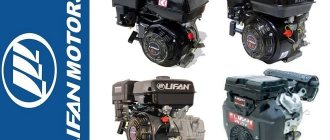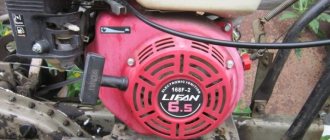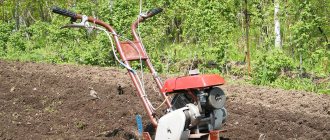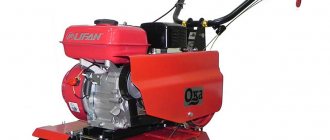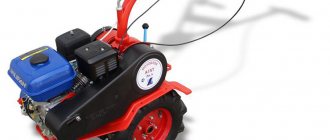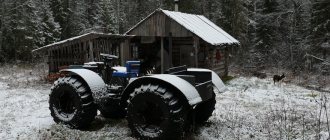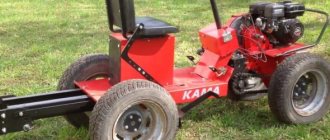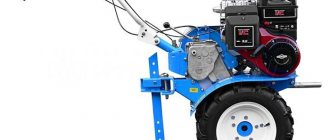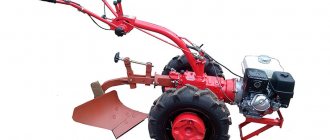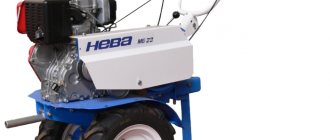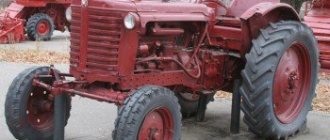Functional failures
Quite often, due to defects in the motor of a walk-behind tractor, its unstable operation occurs. If the engine idles jerkily, and when you try to add gas, it stops altogether, the reason is a lack of fuel. Clean the fuel tank, carburetor and line screens. And when problems appear even at idle, it is advisable to check the centrifugal regulator. Cravings often stick there.
Let's say the walk-behind tractor simply slows down without jerking. In almost all cases, this is due to the introduction of incorrectly configured, inapplicable or simply poorly worn engines. But changing the electrical station is not always appropriate. Setting the best spark plug quality may help. It is also worth imagining the occurrence of defects in the operation of the carburetor float in the high-voltage wire.
In all these situations, there is no particular need to carry out a complete repair. High-quality defect removal is very important. It is stupid to try to increase the compression in all modern engines; anyway, the decompressor will not allow you to do this.
Popular models
The market range includes a huge number of engines from Chinese, Japanese, American and European manufacturers. These are both small-sized devices created for use in the country, and huge, heavy-duty units aimed at field work. The most common models among Russian consumers are produced:
South American Greenfield, which has the best price-performance ratio, is also highly valued. Excellent motors are made by Russian manufacturers. Such units are reliable, relatively cheap, multifunctional and versatile. For example, the UD-2 subcompact engine is suitable for mini garden tractors and autonomous power generators. Modifications created for installation on light and medium-sized tractors, equipped with an air cooling system and a dust filter that prevents clogging of particles with hard particles.
Another example of Russian engineering technologies. Sadko engine. An unusual design solution in its production with the introduction of light duralumin alloy as the body material. Such motors are considered the best option for gardening equipment. The device does not place much strain on the operator’s hands and is compact in size.
Rigid elements located along the entire perimeter of the body contribute to the stability of the walk-behind tractor
and provide good resistance to internal pressure that occurs during combustion of the fuel mixture. Despite their low weight, SADK engines can withstand enormous loads and can operate in adverse weather conditions. Many Russian consumers prefer Japanese engines. Advantages of such devices:
- Compliance with international standards.
- luxury design.
- highest performance.
- Introduction of leading technologies and materials of exceptional properties.
- Compatible with a wide range of mounts.
A typical indicator of the power of Japanese engines. Seven hp..s. They are suitable for installation on walk-behind tractors, pumps, generators, lawn mowers and other garden equipment. Magnum gasoline engines. the best choice for working on large earthen areas. Recommended area. 5 thousand m². Such engines are aggregated with a plow, a harvester, an AL-KO potato planter, a motor pump, a trailer, a high-pressure cleaner and other types of suspended equipment.
Common faults
All difficulties with the engine of agricultural machinery are divided into two broad categories:
- Startup tasks.
- multifunctional failures.
Variants of the variator mechanism are also widespread; it transmits torque and is capable of smoothly changing the gear ratio in the range of intended regulation. Repair must certainly be preceded by painstaking diagnostics. Minor faults can be identified during routine service.
Valve adjustment. a fundamental and necessary procedure to ensure reliable operation of the mechanism and increase its service life. Therefore, it must be carried out at intervals established by the manufacturer. The following tools are needed:
- a set of keys;
- Phillips and flathead screwdrivers;
- narrow probe.
Some models may also require other hand tools. The point of the regulation process is to set the valve clearances of the motor walk-behind tractors to the required value, which is indicated in the manual. If this is not done, this is a common cause of premature engine failure. In more common models, the intake valve clearance is 0.15 mm, the exhaust valve. 0.2. It is installed by turning the lock nut. If the feeler gauge fits freely, the gap is adjusted correctly.
Problems with the supply of fuel mixture are common. If the engine smokes or won't start, check the spark plugs. Malfunctions in the fuel supply system may be the answer to the question why the engine is burning or does not develop speed. If the check reveals that the spark plugs are dry, the cause of the malfunction should be found in the fuel supply system to the cylinders. To solve the problem, you need to do the following:
- Fill the tank with fresh gasoline or diesel.
- Unscrew the fuel valve.
- Clean the drain hole in the reservoir plug.
- Disconnect the fuel line hose from the inlet fitting where it attaches to the carburetor.
- blow out in streams.
If fuel enters the carburetor but does not reach the cylinders, excessive vibration will be felt when trying to start the engine. The problem can be solved by disassembling and cleaning the assembly. You need to blow out the carburetor with a pump. It happens that the engine does not start due to excess fuel. Wet candle. a sign of such a task. Corrected by cleaning the cylinders and pumping the engine. First you need to turn off the fuel supply.
If plaque is found on the spark plug, you need to clean it and check the gap between the electrodes. It should be 0.8 mm. You also need to check for spark. Its absence indicates a probable malfunction in the electronic circuit. A common problem. large gap between the coil winding and the magnetic circuit. If the engine is powered by an electronic starter, failure may be caused by:
- battery discharge
- starter is faulty;
- blow out the fuse.
If the engine starts, but does not develop speed, stops or works intermittently, there may be the following problems:
- The air filter is clogged.
- Deposition of combustion fuel mixtures in mufflers.
- Incorrect carburetor installation.
- Wear of parts of the cylinder-piston group.
The compression should be eight atm. This indicator is checked by connecting a compression gauge to the spark plug hole. The diagnostic procedure consists of rotating the shaft with the starter. If the engine does not turn off, check the function of the switch. As necessary, the contacts are cleaned or the faulty element is changed.
Attachments
Motoblocks Don (popularly Donchak) have gained great popularity due to the wide range of work they perform. In essence, they are mini tractors that are designed for use on small or medium-sized plots.
Milling cutters
Most Don walk-behind tractors come with a set of cutters.
They are used to homogenize the top layer of soil and mix it. Due to the raising of the lower layer, the fertility of the soil and the amount of harvested crops increase.
Here is a video review of how soil is milled using a Don 105R walk-behind tractor:
Plows
Milling cutters are only good on prepared soils.
Plow
When working with virgin lands, they will not be able to enter them, and will constantly jump over. In this case, it is better to use a plow. It goes into the ground and allows you to cultivate an area with high soil density.
When working with a Don walk-behind tractor with a plow, the main task is to make the first trench. The plowing process then becomes much easier.
One wheel is placed in a rut, the hitch is immersed in the ground to the required level. Thus, when driving, each subsequent trench will bury the previous one.
Mowers
Cultivating virgin lands is not convenient from the point of view that they have a large amount of grass that wraps around the plow, cutters or wheels, thereby complicating the movement of the Donchak walk-behind tractor.
Rotary mower
Therefore, it is recommended to remove weeds from the site before doing this.
Mowers will help with this. The manufacturer offers rotary versions of this attachment. Depending on the height of the grass, they can move at speeds of 2 to 4 km/h.
Mowers can be used by utility companies to maintain park areas or by residents of rural areas to make hay for the winter.
Potato diggers and potato planters
Most farmers make money from potatoes. This culture requires a lot of physical effort. Donchak walk-behind tractors together with special attachments: potato diggers and potato planters can make this work easier.
Potato planter Potato digger
Thanks to them, you can sow the plot and harvest the crop much faster, while spending less effort.
Snowblowers and blade shovel
In the winter season, Don walk-behind tractors can help with snow removal. More powerful professional snow blowers are used by utility companies where it is necessary to clear snow over a large area.
Rotary snow blower
If you need to clean the local area or the entrance to the garage, you can use ordinary shovels with Don walk-behind tractors.
Adapters and trailers
Many Don walk-behind tractors are professional and have a lot of weight. Therefore, they need to be constantly guided. In addition, owners have to walk behind their cars. Due to these factors, rapid fatigue sets in. To reduce physical stress on owners, special adapters are provided that allow operation while sitting.
Adapter
When transporting goods, trailers are connected to Don walk-behind tractors. The most convenient dump truck models, which allow unloading by simply lifting the trolley from the front.
Wheels, tracks and lugs
For most work, pneumatic tires are used. equips its devices with wheels with a large diameter and hard tread.
Wheels 5x10 Lugs
Often there is not enough grip on the surface and the Donchak walk-behind tractor begins to slip. In these cases, you can replace regular tires with lug tires.
When moving on snow, another problem arises - a very slippery surface on which the walk-behind tractor cannot drive.
In this case, tracks can be installed that will increase traction due to greater contact with the surface.
How to remove the engine from a walk-behind tractor
To dismantle the power plant, the walk-behind tractor is placed on a flat surface and cleaned of dirt. The protective shield is removed, the accelerator cable is disconnected from the carburetor plate. Then unscrew the bolts that hold the fasteners in place and loosen the drive belt locking pins. Remove the four screws securing the motor. The engine turns left.
The belt is removed from the crankshaft pulley. After which the electrical station is considered disconnected from the chassis. You can change the fastenings as needed. In some models, the wings are removed earlier to facilitate access to the bolts that secure the engine to agricultural machinery.
Installing a Lifan engine on a Ural walk-behind tractor
The factory equipment of Ural walk-behind tractors assumes the presence of a domestic engine. In some cases, the power and performance of such a motor is not enough, so there is a need to remodel the equipment. Equipping a Ural walk-behind tractor with a Lifan engine with your own hands is quite simple, but before starting work you need to decide for what purpose the equipment is being created and select a suitable engine.
Certain engines are suitable for walk-behind tractors of different types and weights, so it is important that the parameters are combined. The heavier the walk-behind tractor itself, the more powerful the engine should be. Models such as Lifan 170F (7 hp), 168F-2 (6.5 hp) are suitable for the Urals. Their installation requires minimal modification.
The main feature that distinguishes Chinese engines from domestic ones is the direction of shaft rotation: for Lifan it is to the left, for factory Ural engines it is to the right. For this reason, the walk-behind tractor is configured to rotate the shaft to the right; to install a new engine, it is necessary to change the position of the chain gear so that the pulley is on the opposite side, which allows it to rotate in the other direction.
After the gearbox is on the other side, the engine is installed in the standard way - the engine itself is bolted, the belts are placed on the pulleys, and their position is adjusted.
Walk-behind tractor engine repair
Just like any type of equipment, a walk-behind tractor requires timely maintenance: oil change, cleaning, engine adjustment, and the like. An electrical station, which is a complex piece of agricultural machinery , is prone to failure. Often you can repair the device without the help of others. You will need an appropriate set of tools and knowledge of the main fundamentals of a walk-behind motor. The equipment is accompanied by an annotation describing the procedure for dismantling and assembling the unit.
READ How much oil is needed in a walk-behind tractor engine
This makes the task somewhat simpler. If the engine runs intermittently, then you first need to check the level of fuel consistency in the tank. Diesel and gasoline engines have different service life. For the former, the usual figure is four thousand m3 / h, while the latter are able to work half as much. There are more circumstances for their release due to increased power, which leads to rapid wear of parts and multifunctional structural parts. Difficulties often arise with the electronic starter switch.
How to repair a motor cultivator yourself?
Is it possible to repair a motor cultivator with your own hands at home? Many owners of such motorcycles are faced with the fact that the engine suddenly stalls, systems do not work well, and malfunctions occur.
What should you do, entrust the job to a specialist or disassemble the device yourself?
Unit warranty or do-it-yourself repairs?
The first step when a breakdown occurs is to check the warranty.
If you still have a warranty card for the product, you must contact the seller and report the breakdown.
Cases that are not eligible for warranty service:
If you used your motor cultivator correctly, and it suddenly breaks down, then check the warranty period.
Types of engines
Gasoline and diesel engines are used for installation on gardening equipment and heavy-duty agricultural machinery. The first ones are distinguished by the highest productivity and efficiency in difficult operating conditions, the others are universal and economical. The diesel engine moves from the rear and supports a huge number of mounts. The best production effect is achieved when working at low speeds.
Such units have a good motor life and high resistance to adverse weather and climatic factors. Two-cylinder models are more needed. They are relatively inexpensive and can withstand high temperatures well. When using such a motor in the summer heat, there will be a fairly normal air cooling system. Gasoline modification incurs huge operational, operating and maintenance costs. Their advantages are durability and reliability.
A four-stroke motor of this type is distinguished by its highest performance and ability to work on heavy soils. A machine equipped with a vertical shaft saves time because it can work smoothly at high speeds. Power units compatible with walk-behind tractors are divided according to the starting method:
- for electronic;
- For driving;
- for combined ones.
Manual drive is found in more economical and outdated models. More common are units with electronic start, which provide easy and quick start-up of the equipment. They are economical, easy to use and reliable. The introduction of an electric motor for a walk-behind tractor is appropriate at the dacha or in your garden. Combined modification. good option. 4-stroke engines designed to process large areas of arable land and agricultural land are based on this multifunctional design.
They significantly simplify the operator’s task, as they allow you to choose the type of convenience for you. Both petrol and diesel models are equipped with automatic speed control. Another classification feature. power indicator. Light walk-behind tractors (less than 70 kg) have engines up to four hp. On medium (71-100 kg) engines with a volume of up to seven liters. With. To work together with heavy (over 100 kg) equipment, power units with eight hp are used. The power limit is set to approximately sixteen hp.
Light and medium-sized walk-behind tractors use two-stroke gasoline or diesel engines with an air cooling system. They are great for tasks in a personal home. Farmers use the most common heavy-duty walk-through tractors equipped with a 4-stroke engine with forced liquid cooling. Depending on the modification, the engine is equipped with a gearbox, chain or worm gear. The latter may have a V-belt or bevels.
Specifications
Gasoline engine models are excellent for walk-behind tractors - Lifan 168F, 168F-2, 177F and 2V77F.
Model 168F belongs to the group of engines with a maximum power of 6 hp. With. and is a 1-cylinder 4-stroke unit with forced cooling and a crankshaft positioned at an angle of 25°.
The technical characteristics of the engine for the walk-behind tractor are as follows:
- Cylinder volume - 163 cm³.
- Fuel tank volume - 3.6 liters.
- Cylinder diameter - 68 mm.
- The piston stroke is 45 mm.
- Shaft diameter - 19 mm.
- Power - 5.4 l. s. (3.4 kW).
- Rotation speed - 3600 rpm.
- Startup is manual.
- Overall dimensions - 312x365x334 mm.
- Weight - 15 kg.
The 168F-2 model is of particular interest to walk-behind tractor users, as it is a modification of the 168F motor, but has an increased service life and higher parameters, such as:
- power - 6.5 l. With.;
- cylinder volume - 196 cm³.
The cylinder bore and stroke are 68 and 54 mm, respectively.
Of the 9 hp engine models. With. highlight the Lifan 177F, which is a 1-cylinder 4-stroke gasoline engine with forced air cooling and a horizontal output shaft.
The main technical parameters of Lifan 177F are as follows:
- Power - 9 l. With. (5.7 kW).
- Cylinder volume - 270 cm³.
- Fuel tank volume - 6 l.
- The diameter per piston stroke is 77x58 mm.
- Rotation speed - 3600 rpm.
- Overall dimensions - 378x428x408 mm.
- Weight - 25 kg.
The Lifan 2V77F engine is a 2-piston V-shaped 4-stroke overhead valve gasoline engine with forced air cooling, a contactless transistor magneto ignition system and a mechanical speed controller. In terms of technical parameters, it is considered the best of all heavy class models. Its characteristics are as follows:
- Power - 17 liters. With. (12.5 kW).
- Cylinder volume - 614 cm³.
- Fuel tank volume - 27.5 l.
- Cylinder diameter - 77 mm.
- The piston stroke is 66 mm.
- Rotation speed - 3600 rpm.
- Starting system - electric, 12 V.
- Overall dimensions - 455x396x447 mm.
- Weight - 42 kg.
The service life of the professional engine is 3500 hours.
Fuel consumption
For engines 168F and 168F-2, fuel consumption is 394 g/kWh.
Models Lifan 177F and 2V77F can consume 374 g/kWh.
As a result, the estimated duration of work is 6-7 hours.
The manufacturer recommends using AI-92(95) gasoline as fuel.
Traction class
Light walk-behind tractors of traction class 0.1 are units up to 5 liters. With. They are purchased for plots of up to 20 acres.
Medium walk-behind tractors with power up to 9 hp. With. cultivate areas up to 1 hectare, and with heavy walk-behind tractors 9-17 liters. With. traction class 0.2 cultivate fields up to 4 hectares.
Lifan 168F and 168F-2 engines are suitable for Tselina, Neva, Salyut, Favorit, Agat, Cascade, Oka vehicles.
The Lifan 177F engine can also be used for installation on medium-sized vehicles.
The most powerful gasoline unit Lifan 2V78F-2 is designed for work in difficult conditions on mini tractors and heavy walk-behind tractors, such as Foreman, Sadko, Don, Profi, Plowman.
Transmission
For a home walk-behind tractor, but as a walk-behind tractor, you will need chains, sprockets and an adapter shaft. Basically, they are taken from decommissioned bikes, cars, and agricultural equipment
. Star hubs are difficult to make without the help of others, using pieces of iron and a lathe, since it is easy to find a detailed sketch on the Internet or on the Internet. A ready-made box for a home product taken from any model of moped. When preparing a homemade box, iron plates and cylindrical discs with teeth are used.
The kinematic diagram of home-made products is created very simply in order to ensure enormous reliability of the functioning of its devices. The transmission of torque from the motor to the intermediate shaft is organized using a standard roller chain with a driving and driven sprocket. The intermediate gear ratio immediately increases and the rotation speed of the output shafts decreases.
From time to time, a so-called reptile crashes into the box of a walking tractor or motor cultivator. This is a gearbox that is needed to obtain leisurely operating speeds (you can figure out how to assemble a reptile).
Installing this device allows you to improve the management of household products and make its operation non-hazardous to humans. The reptile is bought or collected without the help of others. How to make a reptile without the help of others and for this you need, you can look and ask on forums aimed at a specific topic, organized by qualified specialists.
Which engine to choose for a walk-behind tractor
Choosing a motor for a walk-behind tractor
, you should consider:
- expected operating conditions;
- versatility of fastening;
- constructive compatibility with the existing model of agricultural machinery;
- motor service life declared by the manufacturer.
This fundamental unit must be compatible with the chassis and transmission of the equipment and be perfectly proportional to the dimensions. You should pay attention to the presence of a lighting coil, which will allow you to connect headlights to use the device at night.
Technical properties and multifunctional characteristics to consider:
- Departure of the shaft. The best and most common modification of buttons is nineteen or 20 mm. Slightly inferior to the demand units from the spline view. The least common models are conical structures.
- The presence of an oil level monitoring sensor, which is equipped with all engines, not counting ultra-budget ones. This indicator guarantees the durability of the motor.
- Universal mount designed for easy motor installation.
- Double clean air filter or oil bath. Option 2 is easier to maintain. It is compatible with low clearance walk-behind tractors. Perfectly protects the mechanism from the penetration of soil dust and hard particles.
- Motor resource. It is advisable to choose an engine with an indicator of more than three thousand m/h.
Almost all models have an integrated speed controller. When the load changes, the mechanism independently determines the torque, increases production efficiency and saves fuel. It is advisable to choose a gas engine or a diesel unit equipped with such a device. TATA walk-behind tractors with a powerful electric power plant and automatic clutch are in great demand. They are made of high-quality wear-resistant materials that can withstand overheating and precipitation for a long time.
It is recommended to select such equipment for work on large areas of land, languid soils and in difficult operating conditions. For processing personal agricultural land, your own garden and terrain, an engine from China, for example, made by Lifan, is suitable. These are small-sized and multifunctional units that can be used in various business operations. Due to the relatively low price, such power plants are available to a wide range of buyers.
This engine is equipped with a two-valve drive. Lifan engines use only air cooling, which is justified by the scope of implementation of the units. A good Russian analogue for use in households or on a small farm is the Oka derivative tractors produced at the Kaluga Engine plant. This small-sized device does not require enormous physical effort for the operator to operate. The equipment is equipped with a strong but economical power plant.
Oka pedestrian tractors are equipped with an adjustable steering column, are distinguished by a narrow body, reasonable cost and cable control. If you need a weighted model for field cultivation, you can choose cheap but high-quality Belarusian equipment, for example, MDZ-12. This walk-behind tractor is equipped with a massive internal combustion engine with a capacity of twelve horsepower. Structurally, it is placed on one axis, providing the best balancing and maneuverability of the unit.
READ Motoblock Cascade how much horsepower
Reviews of Lifan engines
Vladislav, 37 years old, Rostov region
I installed the Lifan engine on the Cascade walk-behind tractor. It works for a long time, no failures are observed. I installed it myself and bought an installation kit. The price is affordable, the quality is excellent.
Igor Petrovich, 56 years old, Irkutsk region
The Chinese are simply superb. It consumes little fuel and works efficiently. My Foreman took a powerful 15 hp Lifan petrol engine. With. Feels powerful. Works great. Now I am confident in the high quality of Lifan.
Control device
The operation of a homemade tractor or motor cultivator, like any other machine, must be controlled. The control devices for such household products are usually knobs; they are attached specifically to the frame frame. They are made from two thick-walled pipes, bent to provide a comfortable shape (this is perfectly demonstrated).
At their ends, throttle levers and clutches are installed, removed, for example, from an old moped.
The KP and kickstarter levers of the motor cultivator are made of an iron bar with a diameter of 10 mm. The Kickstarter on a homemade product turns back, closer to the operator, thereby making it easier to start the diesel engine. Also, brake and lever transmissions are fixed in a comfortable place.
In a self-propelled tractor, instead of handles, you can make a successful control adapter. For this, the control column of a car with a bipod or removed from the tractor is perfect. In such a mechanism, the bipod acts as a hook, combining the cart with household products. The control adapter uses a ball joint; this makes the hairstyle independent. The entire process of making a homemade hook is best viewed at.
Tips for buying a walk-behind tractor
As with the purchase of any equipment, the price of a walk-behind tractor directly depends on its equipment.
How to choose a walk-behind tractor? - according to your needs and financial capabilities. The cheapest is the basic package. The more equipment installed on a unit, the correspondingly higher its price. In connection with the above, before purchasing a walk-behind tractor, clearly highlight and write down the tasks that this unit should perform on your farm. Based on the list of tasks, choose a model and equipment.
When choosing a walk-behind tractor model, check what is already included in the basic package of the machine. Different models may have different equipment, even in the basic configuration.
Carefully calculate the required power of the walk-behind tractor. Consider the type of soil on your site. For light, loose soil, you can choose a lower engine power for the walk-behind tractor. If the soil is heavy and dense, you will have to turn your choice towards more powerful models.
Having chosen a specific walk-behind tractor model, check what warranty period is provided for the equipment. An important point is the presence of a service center serving this brand in your region.
As for additional attachments, you shouldn’t rush into butter like a cat and buy everything at once. Usually, at first, only equipment for cultivating the soil is purchased. The rest is purchased as needed. This way you can save a decent amount.
Which engine to choose for a walk-behind tractor
When choosing a motor for a walk-behind tractor, you should consider:
- expected operating conditions;
- versatility of fastening;
- constructive compatibility with the existing model of agricultural machinery;
- motor service life declared by the manufacturer.
This fundamental unit must be compatible with the chassis and transmission of the equipment and be perfectly proportional to the dimensions. You should pay attention to the presence of a lighting coil, which will allow you to connect headlights to use the device at night.
Technical properties and multifunctional characteristics to consider:
- Departure of the shaft. The best and most common modification of buttons is nineteen or 20 mm. The units from the spline view are slightly inferior to the demand. The least common models are conical structures.
- The presence of an oil level monitoring sensor, which is equipped with all engines, not counting ultra-budget ones. This indicator guarantees the durability of the motor.
- Universal mount designed for easy motor installation.
- Double clean air filter or oil bath. Option 2 is easier to maintain. It is compatible with low clearance walk-behind tractors. Perfectly protects the mechanism from the penetration of soil dust and hard particles.
- Motor resource. It is advisable to choose an engine with an indicator of more than three thousand m/h.
Almost all models have an integrated speed controller. When the load changes, the mechanism independently determines the torque, increases production efficiency and saves fuel. It is advisable to choose a gas engine or a diesel unit equipped with such a device. TATA walk-behind tractors with a powerful electric power plant and automatic clutch are in great demand. They are made of high-quality wear-resistant materials that can withstand overheating and precipitation for a long time.
It is recommended to select such equipment for work on large areas of land, languid soils and in difficult operating conditions. For processing personal agricultural land, your own garden and terrain, an engine from China, for example, made by Lifan, is suitable. These are small-sized and multifunctional units that can be used in various business operations. Due to the relatively low price, such power plants are available to a wide range of buyers.
This engine is equipped with a two-valve drive. Lifan engines use only air cooling, which is justified by the scope of implementation of the units. A good Russian analogue for use in households or on a small farm is the Oka derivative tractors produced at the Kaluga Engine plant. This small-sized device does not require enormous physical effort for the operator to operate. The equipment is equipped with a strong but economical power plant.
Oka pedestrian tractors are equipped with an adjustable steering column, are distinguished by a narrow body, reasonable cost and cable control. If you need a weighted model for field cultivation, you can choose cheap but high-quality Belarusian equipment, for example, MDZ-12. This walk-behind tractor is equipped with a massive internal combustion engine with a capacity of twelve horsepower. Structurally, it is placed on one axis, providing the best balancing and maneuverability of the unit.
Description of the Don walk-behind tractor
The units are distinguished by a high level of maneuverability and a huge selection of attachments, which makes any model of cultivator an indispensable assistant in the fields, country house, and garden. The walk-behind tractor is characterized by high-quality assembly, ease of operation, and the ability to process difficult areas of soil, especially in places where trees grow.
Future equipment owners can choose the most suitable multicultivator model. Each of them has its own characteristics - different engine power, engine size, chassis width, cost.
The following walk-behind tractor options are available on the market:
The cost of multicultivators varies between 23-56 thousand rubles. The most expensive modifications are Don-1100 and 1000.
Which engine to choose for a walk-behind tractor: types, best models, how to remove, repair, replace
Motoblock engine. a fundamental and integral unit of agricultural machinery. The technical properties of the motor determine functionality, ease of use, reliability, compatibility with mounted devices and the ability of the device to perform the assigned tasks. The power supply must have the necessary performance, good service life and the necessary power reserve. A device equipped with a high-quality power supply makes life easier for summer residents, gardeners and farmers.
How to remove the engine from a walk-behind tractor
To dismantle the power plant, the walk-behind tractor is placed on a flat surface and cleaned of dirt. The protective shield is removed, the accelerator cable is disconnected from the carburetor plate. Then unscrew the bolts that hold the fasteners in place and loosen the drive belt locking pins. Remove the four screws securing the motor. The engine turns left.
The belt is removed from the crankshaft pulley. After which the electrical station is considered disconnected from the chassis. You can change the fastenings as needed. In some models, the wings are removed earlier to facilitate access to the bolts that secure the engine to agricultural machinery.
Types of walk-behind tractor engines
Gasoline and diesel engines are used for installation on gardening equipment and heavy-duty agricultural machinery. The first ones are distinguished by the highest productivity and efficiency in difficult operating conditions, the others are universal and economical. The diesel engine moves from the rear and supports a huge number of mounts. The best production effect is achieved when working at low speeds.
Such units have a good motor life and high resistance to adverse weather and climatic factors. Two-cylinder models are more needed. They are relatively inexpensive and can withstand high temperatures well. When using such a motor in the summer heat, there will be a fairly standard air cooling system. Gasoline modification incurs huge operational, operating and maintenance costs. Their advantages are durability and reliability.
A four-stroke motor of this type is distinguished by its highest performance and ability to work on heavy soils. A machine equipped with a vertical shaft saves time because it can work smoothly at high speeds. Power units compatible with walk-behind tractors are divided according to the starting method:
- for electronic;
- For driving;
- for combined ones.
Manual drive is found in more economical and outdated models. More common are units with electronic start, which provide easy and quick start-up of the equipment. They are economical, easy to use and reliable. The introduction of an electric motor for a walk-behind tractor is appropriate at the dacha or in your garden. Combined modification. good option. 4-stroke engines designed to process large areas of arable land and agricultural land are based on this multifunctional design.
They significantly simplify the operator’s task, as they allow you to choose the type of convenience for you. Both petrol and diesel models are equipped with automatic speed control. Another classification feature. power indicator. Light walk-behind tractors (less than 70 kg) have engines up to four hp. On medium (71-100 kg) engines with a volume of up to seven liters. With. To work together with heavy (over 100 kg) equipment, power units with eight hp are used. The power limit is set to approximately sixteen hp.
Light and medium-sized walk-behind tractors use two-stroke gasoline or diesel engines with an air cooling system. They are great for tasks in a personal home. Farmers use the most common heavy-duty walk-through tractors equipped with a 4-stroke engine with forced liquid cooling. Depending on the modification, the engine is equipped with a gearbox, chain or worm gear. The latter may have a V-belt or bevels.
READ Do-It-Yourself Potato Digger for Motoblock Without Rattle
Common faults
All difficulties with the engine of agricultural machinery are divided into two broad categories:
- Starting difficulties.
- multifunctional failures.
Variants of the variator mechanism are also widespread; it transmits torque and is capable of smoothly changing the gear ratio in the range of intended regulation. Repair must certainly be preceded by painstaking diagnostics. Minor faults can be identified during routine service.
Valve adjustment. a fundamental and necessary procedure to ensure reliable operation of the mechanism and increase its service life. Therefore, it must be carried out at intervals established by the manufacturer. The following tools are needed:
- a set of keys;
- Phillips and flathead screwdrivers;
- narrow probe.
Some models may also require other hand tools. The point of the regulation process is to set the valve clearances of the motor walk-behind tractors to the required value, which is indicated in the manual. If this is not done, this is a common cause of premature engine failure. In more common models, the intake valve clearance is 0.15 mm, the exhaust valve. 0.2. It is installed by turning the lock nut. If the feeler gauge fits freely, the gap is adjusted correctly.
Problems with the supply of fuel mixture are common. If the engine
smokes or will not start, check the spark plugs. Malfunctions in the fuel supply system may be the answer to the question why the engine is burning or does not develop speed. If the check reveals that the spark plugs are dry, the cause of the malfunction should be found in the fuel supply system to the cylinders. To solve the problem, you need to do the following:
- Fill the tank with fresh gasoline or diesel.
- Unscrew the fuel valve.
- Clean the drain hole in the reservoir plug.
- Disconnect the fuel line hose from the inlet fitting where it attaches to the carburetor.
- blow out in streams.
If fuel enters the carburetor but does not reach the cylinders, excessive vibration will be felt when trying to start the engine. The problem can be solved by disassembling and cleaning the assembly. You need to blow out the carburetor with a pump. It happens that the engine does not start due to excess fuel. Wet candle. a sign of such difficulty. Corrected by cleaning the cylinders and pumping the engine. First you need to turn off the fuel supply.
If plaque is found on the spark plug, you need to clean it and check the gap between the electrodes. It should be 0.8 mm. You also need to check for spark. Its absence indicates a probable malfunction in the electronic circuit. A common problem. large gap between the coil winding and the magnetic circuit. If the engine
operates from an electronic starter, failure can be caused by:
- battery discharge
- starter is faulty;
- blow out the fuse.
If the engine
starts but does not develop speed, stops or works intermittently, the following tasks may occur:
- The air filter is clogged.
- Deposition of combustion fuel mixtures in mufflers.
- Incorrect carburetor installation.
- Wear of parts of the cylinder-piston group.
The compression should be eight atm. This indicator is checked by connecting a compression gauge to the spark plug hole. The diagnostic procedure consists of rotating the shaft with the starter. If the engine does not turn off, check the function of the switch. As necessary, the contacts are cleaned or the faulty element is changed.
Principle of operation
Cultivation of the land with a “Master” motor-cultivator is carried out as follows:
- when the engine starts, the translational energy of the piston is converted into torque and transmitted through a gearbox to two short rotors;
- each of the rotors is equipped with a long rod with a cutter placed at the end;
- when the cutters rotate, their sharp knives cut off the upper layers of soil, finely color them and mix them with the lower layers;
- such rotation of the cutters causes the cultivator to move forward while cultivating the soil;
- The depth of penetration of the knives into the soil is adjustable, and if maximum depth is required, the cultivator is weighted with lugs.
Walk-behind tractor engine repair
Just like any type of equipment, a walk-behind tractor requires timely maintenance: oil change, cleaning, engine adjustment, and the like. Electric station, which is a complex unit of agricultural machinery
, prone to failure. Often you can repair the device without the help of others. You will need an appropriate set of tools and knowledge of the main fundamentals of a walk-behind motor. The equipment is accompanied by an annotation describing the procedure for dismantling and assembling the unit.
This makes the task somewhat simpler. If the engine runs intermittently, then you first need to check the level of fuel consistency in the tank. Diesel and gasoline engines have different service life. For the former, the usual figure is four thousand m3 / h, while the latter are able to work half as much. There are more circumstances for their release due to increased power, which leads to rapid wear of parts and multifunctional structural parts. Difficulties often arise with the electronic starter switch.
Operating and maintenance instructions
With proper operation and maintenance of the equipment, it can operate for a long period. The operating instructions are as follows:
- Equipment is assembled and installed, all elements are connected.
- Engines are supplied dry. This moment determines that you need to purchase a suitable lubricant and pour it into the structure. Some models work with a fuel mixture that includes oil.
- The first start must be done carefully. To do this, select idle mode, the engine warms up for several minutes.
- After working for the first 20 minutes, it is recommended to drain the old oil, after which new oil is added. This is due to the fact that at the time of grinding in the main elements, metal shavings may get into the lubricant.
- For the first few hours, it is recommended to use the cultivator at 2/3 power. This will eliminate the possibility of various malfunctions.
- At first, it is recommended to monitor the engine temperature, because... there is a possibility of it overheating.
- If the engine is unstable, you need to stop the walk-behind tractor and then find the cause of the problem.
- After operating the equipment, the surface should be cleaned of various contaminants. In addition, the condition of all main elements is checked, because further operation with malfunctions is not allowed.
Maintenance includes timely oil changes. In this case, you need to periodically add lubricant to the gearbox.
Popular engine models for walk-behind tractors
The market range includes a huge number of engines from Chinese, Japanese, American and European manufacturers. These are both small-sized devices created for use in the country, and huge, heavy-duty units aimed at field work. The most common models among Russian consumers are produced:
- Honda.
- Subaru.
- Lifan.
- Briggs Stratton.
South American Greenfield, which has an average price-performance ratio, is also highly regarded. Excellent motors are made by Russian manufacturers. Such units are reliable, relatively cheap, multifunctional and versatile. For example, the UD-2 subcompact engine is suitable for mini garden tractors and autonomous power generators. Modifications created for installation on light and medium-sized tractors, equipped with an air cooling system and a dust filter that prevents clogging of particles with hard particles.
Another example of Russian engineering technologies. Sadko engine. An unusual design solution in its production with the introduction of light duralumin alloy as the body material. Such motors are considered the best option for gardening equipment. The device does not place much strain on the operator’s hands and is compact in size.
Rigid elements located along the entire perimeter of the body contribute to the stability of the walk-behind tractor and provide good resistance to internal pressure that occurs during combustion of the fuel mixture. Despite their low weight, SADK engines can withstand enormous loads and can operate in adverse weather conditions. Many Russian consumers prefer Japanese engines. Advantages of such devices:
- Compliance with international standards.
- luxury design.
- highest performance.
- Introduction of leading technologies and materials of exceptional properties.
- Compatible with a wide range of mounts.
A typical indicator of the power of Japanese engines. Seven hp..s. They are suitable for installation on walk-behind tractors, pumps, generators, lawn mowers and other garden equipment. Magnum gasoline engines. the best choice for working on large earthen areas. Recommended area. 5 thousand m². Such engines are aggregated with a plow, a harvester, an AL-KO potato planter, a motor pump, a trailer, a high-pressure cleaner and other types of suspended equipment.
Engine Installation
When installing the engine on a walk-behind tractor, you must be careful and follow the sequence of actions. Errors will lead to a reduction in the service life of the unit, rapid wear of parts and lead to malfunction. The following conditions must be met:
- correctly transmit torque from the power station to the box;
- carefully connect the engine to the box or rear frame of the tractor;
There are special installation kits that will help you avoid mistakes when installing equipment. Such sets consist of the following parts:
- Adapter plate. Forks between the engine and gearbox.
- Hubs Installed on the engine crankshaft.
- Fastenings. Provides reliable fixation of the power plant.
When using such a kit, a two-step sequence is needed to secure the motor to the mounting plate and transfer the pulley to the crankshaft. With the help of such a kit, the engine can easily be installed on walk-behind tractors of both Russian and foreign production.
Sources:
https://proposudomoiki.ru/kak-sobrat-dvigatel-motobloka/ https://specmahina.ru/motoblok/dvigatel.html https://www.olx.ua/list/q-%D0%B4%D0% B2%D0%B8%D0%B3%D0%B0%D1%82%D0%B5%D0%BB%D1%8C-%D0%BC%D0%BE%D1%82%D0%BE%D0%B1 %D0%BB%D0%BE%D0%BA/
"Motoblock-master"
Hello! I consider it my duty to warn you that if you do not have the proper education or experience, it is better to contact our workshop. It should be remembered that any mistake at the stage of disassembling or assembling the unit will lead to a significant increase in the cost of repairs and a large loss of time. You can buy any spare parts for a walk-behind tractor or cultivator in our workshop or order cash on delivery by mail. Consultation on questions you are interested in can be obtained by telephone.
What to do if the engine of the old MTZ 05, 06, 12 walk-behind tractor has become unusable? The engine can be repaired. Unfortunately, this is not cheap, and every year there are fewer and fewer spare parts for the old UD 15 and UD 25 engines. Therefore, more and more often, users change the engine, install a Honda GX series or their analogues. They are not as good at pulling from the bottom as the old Soviet UDs, but they are more powerful, more economical, and more reliable. I won’t discuss the resource; by the way, it’s easier and cheaper to repair a Honda engine; spare parts for it are always available. And so: we replace the old UD 15 with a copy of the Honda GX. Copies are offered by different manufacturers: Weima, Rato, Kipor, Magnum and others.
We disconnect the throttle cable, the wire with the magneto, remove the fuel tank, in this case we didn’t have to do this, the walk-behind tractor arrived at the workshop in a semi-disassembled state.
Drain the oil from the gearbox. If it is the same as in this walk-behind tractor, then we also drain the oil from the final drives, left and right.
We unscrew the three bolts on both sides that connect the engine to the gearbox, and disconnect the old engine from the gearbox.
We take the new engine out of the box and place it on the table.
As a rule, engines leave the factory without oil; this is written both on the box and in the instructions.
On the left side of the engine casing there is an information plate which shows that you need to fill the oil up to the lower edge of the thread.
We look at the brand and type of oil in the instructions; as a rule, for this engine it is 10W30 or 10W40, semi-synthetic for gasoline four-stroke engines.
For installation, you will need an adapter plate, and a new clutch hub (the old one will not fit), a cup, if it is in good condition, you can leave the old one, you just have to disconnect it from the old hub and rivet it to the new one, or you can buy a ready-made clutch hub with a cup.
We also need a new throttle cable, the old one will be short. In addition, you will need 10 more bolts with a diameter of 8 mm and a length of 25-35 mm.
Unfortunately, ready-made gaskets are difficult to find. Therefore, we cut out gaskets for the adapter plate; you can use special material for gaskets with a thickness of 1-2 mm. If there is no special material, use thick cardboard and sealant. It is important that the plate is pressed tightly against the engine and gearbox, otherwise oil will leak out of the gearbox between the plate and the engine.
Use bolts of the correct length. It is necessary to take into account that the holes in the rear engine cover are not through; use an engraver when attaching the plate.
Cut out the second gasket.
From the old engine we remove the original adapter, which is located between the engine and the gearbox.
The distance from the edge of the adapter to the clutch cup should be 30 mm.
When we install the adapter and cup on the new engine, this distance needs to be checked.
Unscrew three nuts on each side.
We remove the adapter; if the manual effort is not enough, we help with a hammer.
Remove the clutch cup from the old engine. To do this, you need to bend the lock washer, jam the cup and unscrew the nut, after which we knock the hub together with the cup with light blows.
We inspect the cup; if there are not deep marks from the disks in the grooves, they need to be removed with a file or a grinding machine.
This must be done very carefully, if the grooves are not even, the clutch will fail. After processing, we check the grooves with a new clutch disc.
We cut or cut down the rivets from the hub and then knock out each rivet with a core.
Separate the cup from the hub.
Trying on a new hub. We buy or make steel rivets, diameter 4.5 mm, or drill out the hub and cup for ready-made rivets, rivet length 13-16 mm.
We connect the cup to the hub and rivet it.
We install a key and a hub on the crankshaft of the new engine. If the hub fits in tightly, then first push the hub in, align the grooves for the key on the hub and crankshaft, and hammer in the key with a tool. We clamp the hub with a bolt with a diameter of 8 mm, a length of 50-60 mm, through an engraver and a large washer. The bolt does not need to be locked; the shaft rotates in the opposite direction.
Apply sealant to the adapter. If after dismantling the old gasket remains undamaged, you can use it after applying sealant to it. We connect the adapter to the new adapter plate, using six bolts with a diameter of 8 mm and a length of at least 35 mm.
We check that there is approximately 30 mm from the edge of the adapter to the edge of the cup; a slight deviation of plus or minus 1 mm is allowed.
Taking advantage of the fact that the engine has been removed, we pay attention to the clutch and gearbox. It makes sense to replace the clutch discs, check the condition of the springs and bearings.
We connect the engine to the gearbox; to do this, we position the clutch basket with the protrusion upwards.
We also place the clutch cup on the engine with the groove facing up.
We install a new gasket, apply sealant and connect the engine to the gearbox, without the need to apply excessive force so as not to break the clutch discs. Usually, if everything is set correctly, docking does not pose any particular difficulties. We tighten six bolts, three on each side.
Old throttle cable, short.
Let's install a new cable. We remove the air filter and unscrew the nut with a 10 mm socket wrench, it locks the throttle lever, loosen the nut until the lever begins to move freely. The cable casing and the cable itself are attached in the places provided for this purpose.
We connect the ignition switch wire; for this we use the wire that was previously connected to the magneto. It needs to be connected to the black wire on the new engine that goes under the fuel tank to the ignition coil. To do this, we disconnect the ignition wire, connect the engine stop wire to it, isolate and fix the wires with the clamp provided for this purpose.
Unfortunately, the old stand won't work, but it can be repurposed. For example, like in the picture below.
Or so.
Or like this.
All these homemade stands often cause inconvenience in use, so it is better to buy a stand specially made for this model.
The walk-behind tractor is ready, the next step is launch.
Before starting, you need to open the fuel tap - a flag on the carburetor, which at the bottom must be moved forward from you to the engine.
Then, close the air damper, pull the lever at the top away from the engine, and then pull the starter handle. When the engine starts, the choke should be opened by moving the upper lever forward away from you towards the engine.
The video shows the sequence of starting and stopping the engine.
It is important to remember that after you have stopped the engine, you should always close the fuel valve.
The best reward for work is a happy user.
Good luck.
Author: Martysevich Vasily.
Landline phone: +375(17) 512-37-12. Mobile phones : +375296741674 (A1, Viber and WhatsApp); +375298767878 (MTS).
